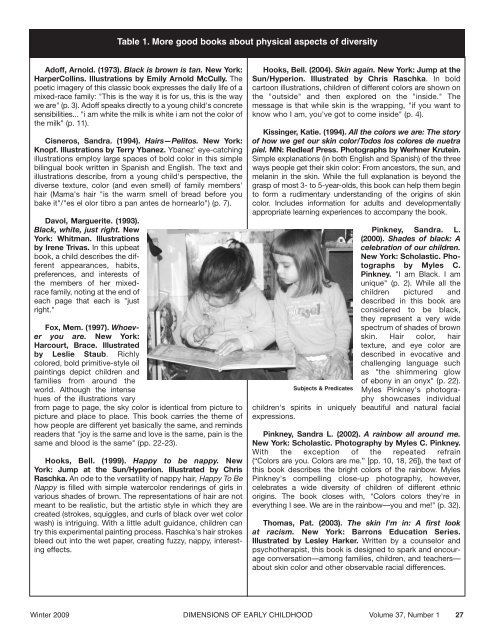their awareness of differences and to develop their - Southern Early ...
their awareness of differences and to develop their - Southern Early ...
their awareness of differences and to develop their - Southern Early ...
Create successful ePaper yourself
Turn your PDF publications into a flip-book with our unique Google optimized e-Paper software.
Table 1. More good books about physical aspects <strong>of</strong> diversity<br />
Ad<strong>of</strong>f, Arnold. (1973). Black is brown is tan. New York:<br />
HarperCollins. Illustrations by Emily Arnold McCully. The<br />
poetic imagery <strong>of</strong> this classic book expresses the daily life <strong>of</strong> a<br />
mixed-race family: "This is the way it is for us, this is the way<br />
we are" (p. 3). Ad<strong>of</strong>f speaks directly <strong>to</strong> a young child's concrete<br />
sensibilities... "i am white the milk is white i am not the color <strong>of</strong><br />
the milk" (p. 11).<br />
Cisneros, S<strong>and</strong>ra. (1994). Hairs—Peli<strong>to</strong>s. New York:<br />
Knopf. Illustrations by Terry Ybanez. Ybanez' eye-catching<br />
illustrations employ large spaces <strong>of</strong> bold color in this simple<br />
bilingual book written in Spanish <strong>and</strong> English. The text <strong>and</strong><br />
illustrations describe, from a young child's perspective, the<br />
diverse texture, color (<strong>and</strong> even smell) <strong>of</strong> family members'<br />
hair (Mama's hair "is the warm smell <strong>of</strong> bread before you<br />
bake it"/"es el olor tibro a pan antes de hornearlo") (p. 7).<br />
Davol, Marguerite. (1993).<br />
Black, white, just right. New<br />
York: Whitman. Illustrations<br />
by Irene Trivas. In this upbeat<br />
book, a child describes the different<br />
appearances, habits,<br />
preferences, <strong>and</strong> interests <strong>of</strong><br />
the members <strong>of</strong> her mixedrace<br />
family, noting at the end <strong>of</strong><br />
each page that each is "just<br />
right."<br />
Fox, Mem. (1997). Whoever<br />
you are. New York:<br />
Harcourt, Brace. Illustrated<br />
by Leslie Staub. Richly<br />
colored, bold primitive-style oil<br />
paintings depict children <strong>and</strong><br />
families from around the<br />
world. Although the intense<br />
hues <strong>of</strong> the illustrations vary<br />
from page <strong>to</strong> page, the sky color is identical from picture <strong>to</strong><br />
picture <strong>and</strong> place <strong>to</strong> place. This book carries the theme <strong>of</strong><br />
how people are different yet basically the same, <strong>and</strong> reminds<br />
readers that "joy is the same <strong>and</strong> love is the same, pain is the<br />
same <strong>and</strong> blood is the same" (pp. 22-23).<br />
Hooks, Bell. (1999). Happy <strong>to</strong> be nappy. New<br />
York: Jump at the Sun/Hyperion. Illustrated by Chris<br />
Raschka. An ode <strong>to</strong> the versatility <strong>of</strong> nappy hair, Happy To Be<br />
Nappy is filled with simple watercolor renderings <strong>of</strong> girls in<br />
various shades <strong>of</strong> brown. The representations <strong>of</strong> hair are not<br />
meant <strong>to</strong> be realistic, but the artistic style in which they are<br />
created (strokes, squiggles, <strong>and</strong> curls <strong>of</strong> black over wet color<br />
wash) is intriguing. With a little adult guidance, children can<br />
try this experimental painting process. Raschka's hair strokes<br />
bleed out in<strong>to</strong> the wet paper, creating fuzzy, nappy, interesting<br />
effects.<br />
Hooks, Bell. (2004). Skin again. New York: Jump at the<br />
Sun/Hyperion. Illustrated by Chris Raschka. In bold<br />
car<strong>to</strong>on illustrations, children <strong>of</strong> different colors are shown on<br />
the "outside" <strong>and</strong> then explored on the "inside." The<br />
message is that while skin is the wrapping, "if you want <strong>to</strong><br />
know who I am, you've got <strong>to</strong> come inside" (p. 4).<br />
Kissinger, Katie. (1994). All the colors we are: The s<strong>to</strong>ry<br />
<strong>of</strong> how we get our skin color/Todos los colores de nuetra<br />
piel. MN: Redleaf Press. Pho<strong>to</strong>graphs by Werhner Krutein.<br />
Simple explanations (in both English <strong>and</strong> Spanish) <strong>of</strong> the three<br />
ways people get <strong>their</strong> skin color: From ances<strong>to</strong>rs, the sun, <strong>and</strong><br />
melanin in the skin. While the full explanation is beyond the<br />
grasp <strong>of</strong> most 3- <strong>to</strong> 5-year-olds, this book can help them begin<br />
<strong>to</strong> form a rudimentary underst<strong>and</strong>ing <strong>of</strong> the origins <strong>of</strong> skin<br />
color. Includes information for adults <strong>and</strong> <strong>develop</strong>mentally<br />
appropriate learning experiences <strong>to</strong> accompany the book.<br />
Pinkney, S<strong>and</strong>ra. L.<br />
(2000). Shades <strong>of</strong> black: A<br />
celebration <strong>of</strong> our children.<br />
New York: Scholastic. Pho<strong>to</strong>graphs<br />
by Myles C.<br />
Pinkney. "I am Black. I am<br />
unique" (p. 2). While all the<br />
children pictured <strong>and</strong><br />
described in this book are<br />
considered <strong>to</strong> be black,<br />
they represent a very wide<br />
spectrum <strong>of</strong> shades <strong>of</strong> brown<br />
skin. Hair color, hair<br />
texture, <strong>and</strong> eye color are<br />
described in evocative <strong>and</strong><br />
challenging language such<br />
as "the shimmering glow<br />
<strong>of</strong> ebony in an onyx" (p. 22).<br />
Subjects & Predicates Myles Pinkney's pho<strong>to</strong>graphy<br />
showcases individual<br />
children's spirits in uniquely beautiful <strong>and</strong> natural facial<br />
expressions.<br />
Pinkney, S<strong>and</strong>ra L. (2002). A rainbow all around me.<br />
New York: Scholastic. Pho<strong>to</strong>graphy by Myles C. Pinkney.<br />
With the exception <strong>of</strong> the repeated refrain<br />
(“Colors are you. Colors are me.” [pp. 10, 18, 26]), the text <strong>of</strong><br />
this book describes the bright colors <strong>of</strong> the rainbow. Myles<br />
Pinkney's compelling close-up pho<strong>to</strong>graphy, however,<br />
celebrates a wide diversity <strong>of</strong> children <strong>of</strong> different ethnic<br />
origins. The book closes with, "Colors colors they're in<br />
everything I see. We are in the rainbow—you <strong>and</strong> me!" (p. 32).<br />
Thomas, Pat. (2003). The skin I'm in: A first look<br />
at racism. New York: Barrons Education Series.<br />
Illustrated by Lesley Harker. Written by a counselor <strong>and</strong><br />
psychotherapist, this book is designed <strong>to</strong> spark <strong>and</strong> encourage<br />
conversation—among families, children, <strong>and</strong> teachers—<br />
about skin color <strong>and</strong> other observable racial <strong>differences</strong>.<br />
Winter 2009 DIMENSIONS OF EARLY CHILDHOOD Volume 37, Number 1 27
















